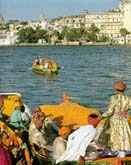What to buy
In Jaipur precious and semiprecious stones are very reasonably priced
here. Other good buys -- meenakari enamelled jewellery, chunky silver jewellery sold by weight, miniature paintings, traditional Rajasthani
mojri slippers, carpets and bright hand printed cotton fabrics.
For
really chic hand printed cotton fashions straight out of Vogue
magazine, try Anokhi, an upmarket store on Tilak Marg.
In Udaipur traditional Pichhai paintings, colourful Rajasthani puppets and rustic
Molela pottery are good choices. There are interesting handicrafts available at the little shops
near the Jagdish Temple.
Jodhpur is the place for very interesting antiques and neo-antiques (!), authentic Jodhpur
riding breeches, colourful hand printed cotton fabrics and traditional
Rajasthani mojri slippers.
Cultural Activities

Rajasthan famed for its rich variety of folk dance and folk music
forms. Each area has its own very special type of dance, ranging
from the hypnotic, sinuous dance of the Kalbeliya nomads of Jaisalmer
to the vigorous, energetic drum dance of Jalore, from the graceful,
rhythmic ghoomar dance performed by the ladies of Udaipur to
the daredevil fire dance of Bikaner, performed on live burning
coals.
Also you'll discover a fascinating variety of folk music here,
ranging from the simple, haunting music of the wandering desert
minstrels of the Langa and Manganiyar communities to the somewhat
more sophisticated mand, traditionally sung at the courts of the
Rajput rulers.
Rajasthan is also known for its puppet shows, based on popular
legends, and for the Pabuji ki phad, a unique bardic narration
of the Pabuji legend, illustrated by a 30 feet illuminated scroll,
like some medieval forerunner of the modern animated film!
The best showcase of Rajasthani culture is the famed Desert Festival
that is held in Jaisalmer each year, where the finest performers
from all over the state gather to vie with each other for honours.
In October and November, the annual Pushkar Fair turns into a colourful
bazaar with handicrafts of all sorts being sold, and camels, horses
and bullocks are being bought and sold in the hundreds.

